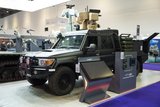EMS Technologies to provide beam-management components for ground radar system
EMS Defense & Space, a division of EMS Technologies, Inc., continues its position as a solutions leader in providing beam-management capabilities for global radar systems today with the latest award from an Asian radar customer to provide the phase-control elements within the phased array antennas for the customer's large S-band-based ground radar system.
As part of a $2.8 million, one-year contract, EMS D&S will provide volume quantities of high-accuracy phase shifters that are integral to the customer's radar-based ground defense infrastructure to assure its defensive readiness capabilities.
"EMS D&S has been a trusted supplier for this specific customer's ground radar program for the past 15 years. This latest award is a continuation of an existing design and reflects our customer's confidence in EMS as a manufacturer of highly reliable technology that can withstand very harsh environments," said Norm Johnson, vice president, Business Development for EMS D&S. "This award leverages our high-volume manufacturing capabilities for providing large quantities of hardware within an aggressive schedule. It also confirms our confidence in the high reliability of our phase shifters once deployed on the radar."
EMS D&S has provided more than 14,000 phase shifters to date. The company expects new product deliveries to begin in 2011.
Source: EMS Defense & Space
More from Digital Battlespace
-
![Babcock nears first customer for Nomad AI translation tool]()
Babcock nears first customer for Nomad AI translation tool
Nomad can provide militaries with real-time intelligence, saving critical time on the battlefield.
-
![AUSA 2025: Israel’s Asio Technologies to supply hundreds of improved Taurus tactical systems]()
AUSA 2025: Israel’s Asio Technologies to supply hundreds of improved Taurus tactical systems
Taurus operates alongside the Israel Defense Forces’ Orion system which supports mission management across tens of thousands of manoeuvring forces, from squad leaders to battalion commanders.
-
![AUSA 2025: Kopin pushes micro-LED plans as China moves faster]()
AUSA 2025: Kopin pushes micro-LED plans as China moves faster
The plan for the new displays follows fresh investment in Kopin’s European facilities by Theon and an order for head-up displays in fielded aircraft, with funding from the US Department of Defense.
-
![AUSA 2025: Persistent Systems to complete its largest order by year’s end]()
AUSA 2025: Persistent Systems to complete its largest order by year’s end
Persistent Systems received its largest ever single order for its MPU5 devices and other systems earlier this month and has already delivered the 50 units to the US Army’s 4th Infantry Division.
-
![Aselsan brings in dozens of companies and systems under the Steel Dome umbrella]()
Aselsan brings in dozens of companies and systems under the Steel Dome umbrella
Turkey has joined the family of countries attempting to establish a multilayered air defence system with government approval in August 2024 for the effort landed by Aselsan. Dubbed Steel Dome, the programme joins Israel’s Iron Dome, the US Golden Dome, India’s Mission Sudarshan Chakra and South Korea’s low-altitude missile defence system.
-
![DSEI 2025: MARSS unveils new agnostic multidomain C4 system]()
DSEI 2025: MARSS unveils new agnostic multidomain C4 system
MARSS’ NiDAR system has been deployed using sensors from static platforms to provide detection and protection for static sights, such as critical infrastructure, ports and military bases.



























